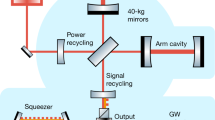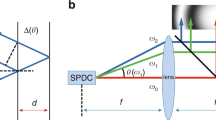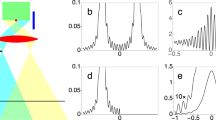Abstract
THE development of atomic time standards and high-speed recording techniques has allowed the extension of radio interferometry to baselines extending thousands of miles. The amplitude, rather than the power, of the received radiation is recorded separately at two or more stations with accurate time control, and the interference pattern is later recovered by cross-correlating the signals by digital1,2 or analogue3 methods. The measurements are usually described in classical terms, for the observations are well outside the domain of quantum phenomena. A discussion of the technique in quantum terms, however, raises an interesting form of the quantum interference paradox that Einstein, Bohr and others debated so vigorously4 40 years ago, in the discussion of the two-slit interference pattern shown in Fig. la. Any attempt to determine which slit a photon or an electron passes through must result in the destruction of the interference pattern.
This is a preview of subscription content, access via your institution
Access options
Subscribe to this journal
Receive 51 print issues and online access
$199.00 per year
only $3.90 per issue
Buy this article
- Purchase on Springer Link
- Instant access to full article PDF
Prices may be subject to local taxes which are calculated during checkout
Similar content being viewed by others
References
Moran, J. M., Crowther, P. P., Burke, B. F., Barrett, A. H., Rogers, A. E. E., Ball, J. A., Carter, J. C., and Bare, C. C., Science, 157, 676 (1967).
Bare, C. C., Clark, B. G., Kellermann, K. I., Cohen, M., and Jauncey, D. L., Science, 157, 189 (1967).
Broten, N. W., Locke, J. L., Legg, T. H., McLeish, R. S., Richards, R. M., Chisholm, R. M., Gush, H. P., Yen, J. L., and Galt, J. A., Science, 156, 1592 (1967).
See, for example, Bohr, Niels, Atomic Physics and Human Knowledge, 32 (Science Editions, New York, 1961).
Serber, R., and Townes, C. H., Quantum Electronics, (edit. by Townes, C. H.), 233 (Columbia University Press, New York, 1960).
Author information
Authors and Affiliations
Rights and permissions
About this article
Cite this article
BURKE, B. Quantum Interference Paradox. Nature 223, 389–390 (1969). https://doi.org/10.1038/223389a0
Received:
Issue Date:
DOI: https://doi.org/10.1038/223389a0
Comments
By submitting a comment you agree to abide by our Terms and Community Guidelines. If you find something abusive or that does not comply with our terms or guidelines please flag it as inappropriate.



